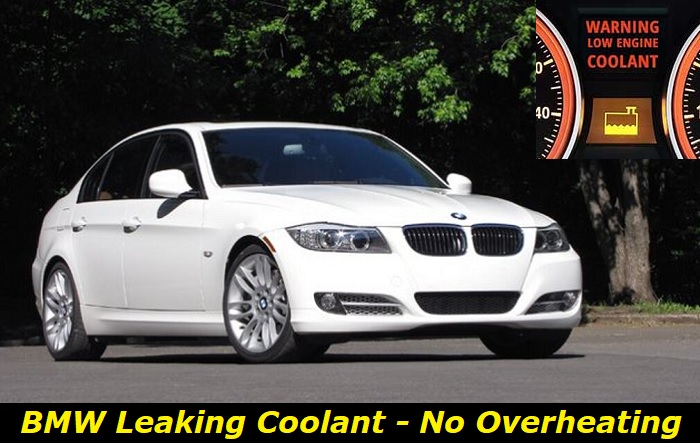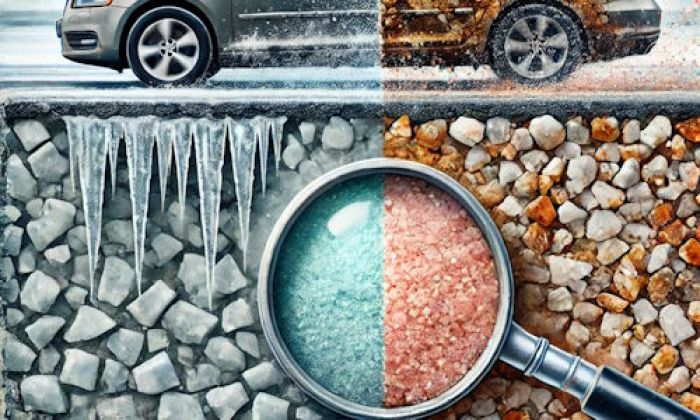Coolant plays an irreplaceable role in ensuring your BMW engine operates in an optimal environment. It reduced the chance of encountering an overheated engine while driving. It also lubricates the water pump and prevents water damage.
Coolant leaks highlights
- Level of urgency:very high
- Commonreasons:cooling equipment failure, pipe connections, radiator damage
- DIY diagnostics:possible but complicated
- DIY repair:mostly impossible
- Price of repair:$350 - $1,500
- Time for repair:3 - 8 hours
- If ignored:overheating, equipment failure

What's an Engine Coolant?
Too much cold is not favorable for your engine. In the same manner, high heat endangers your engine. The friction produces lots of heat. On top of that, the internal combustion system also yields too much heat. That's the reason why we have coolants in our engines.
Engine coolant (antifreeze) is a glycol-based fluid that absorbs excess heat as your engine runs. It works with other components in your engine's cooling system to maintain an optimal temperature. The combustion system produces lots of heat that can damage the entire engine if left unabated.
The cooling system houses a water pump, radiator, fan, and thermostat.
The water pump disseminates the coolant. The radiator pulls out the heat absorbed by the coolant. The fan directs cool air into your radiator when your BMW is not moving. Lastly, the thermostat keeps the coolant's temperature in check.
As the coolant flows through your engine, it absorbs the heat. The coolant then leaves the engine and goes to the radiator for a cooling session. The air flowing into and out of the car's radiator will cool the coolant before releasing it back to the engine for another round of heat absorption.
The coolant will only pass through the radiator if prompted by your car's thermostat.
Signs of Coolant Leak
Unmitigated coolant leaks cause irreversible damage to your engine. Therefore, check for the following signs to avert possible engine replacement.
- Leaked Fluid Under the Car
Coolant leak sometimes leaves greenish, bluish, pinkish, or orange fluid under your car. Coolant manufacturers use these colors to make it easier to differentiate coolant leaks from other leaks.
- Poor Gas Mileage
Your engine requires an optimal temperature to operate efficiently. When the engine lacks enough coolant, it causes an overheated engine. Consequently, an overheated engine will burn more fuel to perform at the same level as a properly cooled engine.
- Overheated Engine
The engine's internal heating system will stop functioning as expected if your BMW has inadequate coolant. Also, the leaking coolant may force the water pump to pump air into the cooling system causing airlocks.
Airlocks often disrupt the cooling system's flow. The water pump may fail to circulate the coolant because of these locks.
- Odd Sweet Smell
Coolants emit sweet scents. Therefore, you may need to check your engine for leaks if you perceive a sweet smell from your car's cabin.
- Warning Lights
Sometimes, you may see coolant warning lights on your dashboard instead of an overheated engine. The rising temperature in your engine can also trigger warning lights.
Why is the Car Losing Coolant but not Overheating?
You caught the leak issue early on if the car is not overheating but running low on coolant because of leaks. In most cases, defects that cause a high temperature in the engine occur before your automobile shows signs of an overheated engine.
If you continue driving it without fixing the coolant leakage, you'll end up with a blown cooling system. Moreover, the wait may increase the total cost you'll spend to repair the leakage and the damaged cooling system.
What Causes Coolant Leaks?
BMW's engines are some of the most durable motors on the market. Still, their enviable durability doesn't exempt them from natural wear, a notorious cause of coolant leaks.
The cooling system goes through natural wear due to the abuse it endures to maintain a healthy engine. The wear may manifest as corrosion on various components of your cooling system, cracks or holes in the hoses, a worn-out head gasket, or a loose radiator cap. All these are the primary contributors to coolant leaks in BMWs.
Therefore, look for the following to locate the source of the coolant leak.
- Cracked or Worn-Out Radiator
The radiator is prone to wear, tear and abuse because of what it does to cool your engine and its location. The radiator encounters rock strikes or impacts from various things as you drive your car. The rock strikes may cause holes or cracks in the radiator.
Apart from the holes, the gasket seal separating the oil tank and the radiator may wear off, resulting in a coolant leak. The hoses connecting the radiator and other components within the cooling system also become brittle over time.
- A loose Radiator Lid
The radiator endures lots of pressure due to its cap and the seal fortifying it. However, the seal may start deteriorating as your car ages. The loose-fitting lid may allow the coolant to spill out of the radiator. An unfastened radiator lid may go unnoticed because you'll keep losing your coolant without overheating the engine.
- A Defective Head Gasket
The head gasket blocks the coolant from leaking and mixing with other fluids in the engine. So, any damage to the head gasket may cause coolant leaks. Sadly, these leaks are not external.
When it's damaged, the coolant will flow into the engine. The engine oil may mix with the coolant or come in contact with the spark plug. It is detrimental to your engine.
- Corrosion on the Water Pump
The water pump distributes the coolant throughout your engine. A belt aids the distribution process. Sadly, the belt is prone to corrosion. Consequently, the deterioration may lead to a coolant leak.
The water pump can also suffer from natural wear or external damage leading to a coolant leak.
- Weakened Expansion Tank
You'll see a plastic container beside the engine when you peep under your hood. That's the expansion tank.
The expansion tank (commonly known as an overflow tank) prevents radiator hoses from blowing due to the pressure in the cooling system. Over time, it may weaken due to temperature changes and too much pressure in the cooling system. The weakening may lead to leaks.
Coolant Leak Detection
Sometimes, it can be challenging to see cracks or holes in the radiators, hose, water pump, or gasket. Here are the various options you can use to uncover the source of the coolant leak.
Option 1: Fresh Puddle of Coolant Leak Under Your Car
- Park your BMW in a well-lit area. If possible, do it during the day to take advantage of daylight. Also, park it in a clean and dry driveway or pavement.
- You'll have to let the engine cool down before inspecting it. You don't want to do it while the coolant is pressurized, hot, and boiling.
- After 10 to 15 minutes of parking, look under the car for any bluish-greenish fluid. If you can see any fresh puddle of colored fluid under it, check the car's underside for bluish-greenish droplets.
- If you notice any fresh puddles or stains under the vehicle, lift the hood and inspect the engine bay. Start by sniffing to locate the source of the coolant smell.
- Also, look out for signs of leakage around the radiator cap. Look for colored residue around the cap or hoses throughout the engine.
Option 2: Clean the Radiator and Hoses
Park the car in a well-lit space. Let the engine cool down. Once it has cooled down, tighten the radiator lid and clean the radiator and hoses.
Start scanning for new signs of coolant leaks on the radiator or the hoses.
Option 3: Use a Cooling-System Pressure Tester
The pressure test will assess whether there are leaks in your vehicle's cooling system. Rent one from an auto shop or let your mechanic do it for you.
Once you have the pressure tester, attach the tester close to the radiator cap. Manually pump the tester until the gauge shows the same pressure as that on the radiator lid.
Let your vehicle remain in that pressurized state for 20 to 30 minutes. Once the waiting period lapses, check for leaks throughout your car's cooling system. Also, check whether there have been changes in the tester's pressure gauge. A lower pressure reading than previously set indicates a coolant leakage.
Concluding Thoughts
Don't drive a car even if you notice a minor coolant leakage. Every second you drive your BMW with a coolant leakage will eventually leave the cooling system fluidless. You also risk introducing airlocks into the cooling system leading to high temperatures in your engine.
Therefore, fix it once you locate the source of the leak. Besides, your car needs enough coolant to maintain a favorable temperature level in your engine. You can seal the leaking point at home or take it to your mechanic.
About the authors
The CarAraC research team is composed of seasoned auto mechanics and automotive industry professionals, including individuals with advanced degrees and certifications in their field. Our team members boast prestigious credentials, reflecting their extensive knowledge and skills. These qualifications include: IMI: Institute of the Motor Industry, ASE-Certified Master Automobile Technicians; Coventry University, Graduate of MA in Automotive Journalism; Politecnico di Torino, Italy, MS Automotive Engineering; Ss. Cyril and Methodius University in Skopje, Mechanical University in Skopje; TOC Automotive College; DHA Suffa University, Department of Mechanical Engineering






Add comment